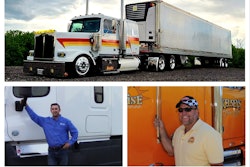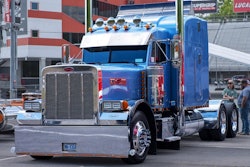In an era of idling prohibitions and $4 fuel, the power switch is back on for truck stop electrification.
Given a choice between a truck stop that offers shore power and one that doesn’t, owner-operator Michael Ben-Dror leaves no doubt where his loyalties lie: “I will choose the one that does.”
Ben-Dror, leased to Anderson Trucking Service, doesn’t face that choice most of the time. At mid-year, a U.S. Department of Energy database listed just 40 truck stops that offer electrical hookups, although more installations are expected this year and the next.
Yet for the first time since the former IdleAire abruptly closed its doors in early 2010, providers of truck stop electrification (TSE) are jumping into the market. At least five companies are negotiating with truck stops and building new sites. Though truckers and truck stop operators have been cautious about embracing the new technology, TSE is expected to spread as state and local governments impose more idling restrictions and diesel fuel prices remain high and volatile.
TSE company reps are fond of noting the chicken-or-egg dilemma facing the industry: Must the electric network expand before more usage will occur? Or must operator demand first increase before there is more infrastructure development? For now, federal grants aimed at reducing carbon emissions and idling remain the primary funding source for expanding the infrastructure.

Jim Bianco, owner of TSE provider CabAire, acknowledges his company is in the business because of federal and state funding. For now, he says, “We probably will not go out on our own.”
Other TSE providers say the key to stimulating truck stop operator investment will be greater demand from owner-operators and fleets willing to pay $1 or $2 an hour for service. Yet carriers are reluctant to commit to retrofits and new vehicles with on-board electric outlets or inverter/chargers unless a TSE infrastructure is in place to accommodate them, says Alan Bates, Shorepower Technologies director of marketing and strategic development. Only 20 percent to 30 percent of today’s trucks are equipped with outlets.
“I think owner-operators who are paying their own expenses are going to be your early adopters,” says Ken Neal, president of EnviroDock, a TSE service provider with three installations.
“Items 1 through 5 are trucker education,” says Jonathan Overly, executive director of the East Tennessee Clean Cities Coalition. “If we drive the benefits to the truckers and they speak to the travel plazas about putting in the equipment,” he contends, plaza operators will listen.
Those truck stop operators also need education, says Dave Orton, marketing manager at Cascade Sierra Solutions, an Oregon-based non-profit involved in reducing diesel emissions and saving fuel. “The technology is viable and will expand … but there’s been a half-step backward to overcome.”
A few years ago, the industry was more than three times its current size. The pioneering Knoxville, Tenn.-based IdleAire operated thousands of stations at 130 sites in 34 states. Its invention of providing not just electricity, but in-cab hot and cold air and telecommunications services won awards and attracted devoted users.
Within a few years of its founding, though, its labor-heavy operation and haphazard site selection (some highway exits had three separate installations) led to large losses. The company declared bankruptcy in 2008. Bondholders ran IdleAire while seeking new owners, then closed the company in 2010. Later that year, new investors Convoy Solutions bought the intellectual property and assets, reopened more than 20 sites and shortened the name to IdleAir, hoping for a fresh start.
IdleAir has accumulated equipment from the TA sites, says Mike Fielden, chief operating officer of IdleAir, and plans “to redeploy at truck stop chains and independent sites.” Equipment is available at about 1,000 positions at Pilot/Flying J, Sapp Bros., Love’s and a few franchise TA and Petro facilities in nine states.
Fielden says the company, which has adopted a lower-cost business model, is looking to add sites in truck-heavy East Coast corridors and Southern California. “We want to build back to 100 sites over the next two to three years,” he says.
IdleAir has to deal with jaded truck stops, as well as trucker complaints about past service. For example, some users say they would get smoky air from a previous user. To combat that, every location has a “hotel-grade cleaning machine to clean HVAC units after each usage,” Fielden says. Plus IdleAir attendants are on hand during peak times to clean the units and assist customers, he says, with the busiest locations employing more than one.
TSE “should be attractive for truck stops because the entire cost of infrastructure, for the most part, is paid for by DOE contracts,” Orton says of the Shorepower Truck Electrification Project his organization is working on with Shorepower Technologies to provide electrical plug-in pedestals at 50 sites. “It’s revenue-generating opportunity for them.”
TravelCenters of America, which removed all IdleAire units from its facilities, is monitoring electrification demand and alternatives before making investments, says Tom Liutkus, marketing vice president. He says the company is also evaluating driver use of auxiliary power units. In a TA poll, 38 percent of drivers said they had an APU and another 18 percent said they planned to buy one within 12 months.
“Depending on the success of APUs in penetrating the market more quickly, TSE alternatives might become less important on truck stop parking lots,” he says.
For truckers, the appeal is finding an affordable option that reduces idling, engine wear and fuel costs and is easy to use. Electrification costs range from $1 to $1.99 an hour, sometimes with a setup fee.
Truckers also are confronting a growing array of state and local jurisdictions that ban idling or limit it to a few minutes. “Tough part for law enforcement is how do you go to a truck driver, say, in Massachusetts when it’s zero degrees out and tell him he has to turn off his engine,” Neal says.
The TSE market is wide open for growth, and not just at truck stops. Service providers are also approaching ports, distribution centers, warehouses and toll road rest areas. The question is if and how quickly installations will materialize, and the extent of continued government funding.
Sales Manager Roger Southall of TSE provider AireDock is optimistic about the answers: “By 2013 we’ll be all over the place.”
Where to hook up
The U.S. Department of Energy keeps an online list of truck stop electrification sites, including details about offerings at each one. Visit www.afdc.energy.gov, search for “truck stop electrification,” select “site locator,” and then “view all stations.”
TSE PROVIDERS
Other than IdleAir, which has close to half of the existing TSE sites in place, here are the other four providers and their plans.
Shorepower Technologies offers a simple system: electricity via an extension cord connected to a stationary pedestal. The Portland, Ore.-based company has seven installations in Washington State and Oregon and another in Kenly, N.C. The sites include six to 12 pedestals, each serving two to four trucks.
They’re teaming up with Cascade Sierra Solutions to locate TSE at 50 truck stops under the Shorepower Truck Electrification Project, funded by a $20 million U.S. Department of Energy grant. Target installation sites are along major truck lanes, such as I-5, I-10, I-70, I-80, I-90 and I-95.
Dave Orton of CSS says the goal is to have the sites with an average of 24 charging connections installed by 2012. STEP also will provide rebate money to independent owner-operators and fleets to retrofit vehicles with idle-reduction equipment.
Truck stop reception has been mixed. “If a truck stop had previous experience with IdleAire, then they may have a negative impression,” says Shorepower’s Alan Bates. “If the operator has a vision of truck stop electrification that’s coming, they are on board.”
AireDock’s system delivers filtered air for heating and cooling and power for in-cab use. The Belchertown, Mass.-based company’s Roger Southall says it has 10 sites installed or in progress, with plans for more than 500 units in place at 20 sites this year.
Southall says most of the funding comes from federal grants or economic stimulus funds. The ownership options are for truck stops to apply for grants and own units – Southall says few have applied – or for AireDock to apply for grants, own the units and share revenue with the truck stop.
Potential sites are being identified within geographic areas with high pollution concentration.
CabAire, a division of electronics manufacturer Control Module Industries, has sites installed at truck stops and state-run travel centers on turnpikes. The Enfield, Conn.-based company, which is also providing electrification at the Port of New Haven, Conn., is testing its Lombardi Travel Plaza installation on the New Jersey Turnpike to see if TSE is viable. The company is pitching its service to fleets and truckers, offering giveaways and posting a video in the drivers’ lounge. “We want to see if it will make a difference,” Bianco says. “If we can make it work at Lombardi, we stand a chance at other places. If it won’t work at Lombardi, it won’t work anywhere.”
EnviroDock offers various products. The E-Dock stationary unit is mounted to a concrete pedestal that delivers filtered air through a window control panel. A unit on wheels can be moved where needed. Its product lineup also includes a stationary shore power unit called PowrDock that provides power to trucks that are shore power-capable or have electric APUs.
Ken Neal says the company is also working on a battery-powered portable system that will be independent of the power grid. To date, the company of Ashland, Va., has limited visibility, with small installations at the Port of Albany, N.Y., a Canaan, N.Y., truck stop and its largest presence with 30 E-Dock and 10 PowrDock units at a Dandridge, Tenn., travel plaza.
“We’ve found truck stop owners are still hesitant to put in truck stop electrification,” Neal says. “They don’t understand the return on investment yet.”
WHAT THE USERS SAYS
Charles Claburn
A former owner-operator who now drives the truck owned by “Ice Road Truckers” competition winner Ray Veilleux, Claburn is a TSE devotee. “I loved it because I didn’t have to idle the truck, and I could watch TV,” says Claburn, who lives in upstate New York. “It’s 375 miles from one end of New York State to the other and the state has very tough idling laws. When you couldn’t find a place to hook up, you risked getting a ticket. It’s the same in a lot of other states.”
So Claburn carefully plans his hauls of farm machinery and specialized equipment, looking for truck stops with electric service. “At $1.25 an hour you can’t beat it,” he says. “For example, I stopped in West Memphis, Ark., rather than go across Arkansas because I didn’t think I could find IdleAir where I was going. I deliberately shorted myself eight hours of drive time because I wanted to be comfortable for the weekend and not burn $4-a-gallon fuel.”
Michael Ben-Dror
An owner-operator leased to Anderson Trucking Service, Ben-Dror used to connect three to four times a week, but now he only finds service a couple times a month. “We lost so many locations in areas where I spend a majority of my time,” he says, which has been mostly east of the Mississippi River.
As an early customer, York, Pa.-based Ben-Dror has window adapters for using IdleAir and CabAire heating/cooling equipment. He’s upset that some truck stops have removed TSE stations. “It makes no sense to me with the emphasis on going green and [reducing] the carbon footprint that we lose the ability to turn off our trucks,” he says, adding that he lets the truck stops know they should offer the service.
Ben-Dror says TSE saved him a big tow bill. His alternator was failing and the truck stop couldn’t fix it. He knew if he turned off the truck, he wouldn’t be able to start it again. Instead, he used an IdleAir extension cord to get power. “I charged my batteries all night and was able to start the truck the next morning and drive it to the dealership,” he says.
Bryan Richardson
The owner-operator, who runs B&R Transport from Long Beach, Calif., plugged into IdleAire a few times before the company shut down and used AireDock service once in Florida.
After idling through too much diesel, though, he bought a $200 generator a year ago. He cranks up the generator when he needs heating and puts a $100 portable air conditioner in his truck window when he wants cooling.
He says the generator holds four gallons of diesel, costing him about $16 to run overnight, compared with more than twice that amount of diesel when idling. “I got tired of waking up in the morning and seeing my fuel gauge was down a bit from idling,” he says.
Richardson says it requires a little effort to set up his generator outside his truck, but it’s cheaper than an auxiliary power unit or idling.
Richardson’s only complaint with TSE is that many parking stalls were set up for bobtails and didn’t have enough space to accommodate tractor-trailers.
Bill Brady
The Las Vegas-based owner-operator, leased to Landstar, says he used the former IdleAire dozens of times before it closed.
Brady says he had a few connectivity problems with IdleAire’s Internet. The heating and AC suited him, although he says he would have wanted cooler temperatures. “What I didn’t like was when the time ran out, it ran out immediately,” he says. “I didn’t like the way they had the payment system set up.” He also recalls the service was increasing in price before it was shut down.
Brady is waiting to find TSE where he runs. In the meantime, he’s idling when he takes breaks. “I don’t have much choice,” he says. “They should concentrate on the states that have no-idle laws. For us it’s getting a little ridiculous to pay these [fuel] prices.”
Rick Butler
Leased to E&H Transport of Carlsbad, Calif., the owner-operator picks up slot machines in Reno, Nev., and delivers them around the country. He used Shorepower and the former IdleAire up to four times a week. “It was nice to go where they had IdleAire and less idling,” he recalls. “You get a lot better sleep.”
Butler, a former IdleAire Gold member, says he would look for specials the company offered to get reduced rates or free hours. Occasionally, tractor-trailers were parked in spaces designated for TSE, including wide loads that grabbed extra space. “They leased the spaces but it didn’t guarantee a slot,” he says. “You could call ahead and it would work out sometimes, but not always.”
Butler says he could use IdleAir now for the shore power to run his CPAP machine for his sleep apnea instead of the extra battery he uses for it. “I charge my spare truck battery, connect an inverter and use that for microwave, TV or to recharge something,” he says.
WIRED AT CROSSVILLE
Finding truck stops that offer electrification is difficult, but the Eco Travel Plaza in Crossville, Tenn., beats them all.
The independently owned facility, on I-40 about 70 miles west of Knoxville, is the only truck stop in the U.S. that offers power at all of its parking spaces – in this case, 50. In addition, equipment from two service providers – AireDock and Shorepower Technologies – is available.
Eco Travel Plaza also stands out by using solar power to generate 35 kilowatts of its power needs. The business extends its green commitment by using LED lighting; recycling glass, paper and plastic; and applying window film to reduce heat and air conditioning usage.
The facility’s owners received a $580,000 EPA grant to install equipment and kicked in $300,000 of their own.
“This location stands out because it shows what can be done to reduce Class 8 truck idling and make it comfortable for drivers – a win-win for everyone,” says Jonathan Overly, of the East Tennessee Clean Fuels Coalition that collaborated on the project.












